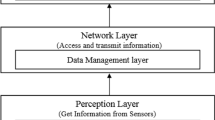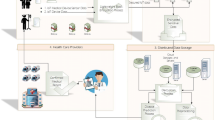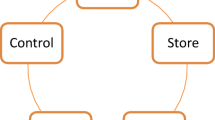Abstract
People who lead hectic lives daily suffer from a variety of illnesses, including diabetes, high blood pressure, hypertension, etc. For someone to survive, they must become aware of these illnesses promptly. The Internet of Things (IoT) and cloud computing are the two critical prerequisites for digital healthcare. In the present research, the attacked data are detected and removed using the security module to enhance the security of the healthcare system. However, an accurate prediction mechanism is needed for the early diagnosis of the diseases. To predict the sickness and its severity more accurately, a unique Dragon Fly-based Generalised Approximate Reasoning Intelligence Control (DF-GARIC) is devised in this article. This system was primarily responsible for preprocessing the cloud medical records entered into the system. Additionally, the regression algorithm extracts the relevant features. Based on the retrieved features, the dragonfly function is used to classify the disease and estimate its severity. Subsequently, a warning is given to the providers for the abnormal condition via SMS or e-mail. The system validated a higher accuracy level of 99.8% from the MATLAB execution.














Similar content being viewed by others
Data availability
Data sharing is not applicable to this article as no datasets were generated or analyzed during the current study.
References
Verma A, Agarwal G, Gupta AK (2022) A novel generalized fuzzy intelligence-based ant lion optimization for internet of things based disease prediction and diagnosis. Clust Comput 25(5):3283–3298. https://doi.org/10.1007/s10586-022-03565-8
Ankit V, Gaurav A, Amit Kumar G (2020) Real time health monitoring systems: a review on disease prediction and providing medical assistance to the patients by the data mining techniques and cloud IoT. Int J Control Assoc 13(4):162–180
Verma A, Agarwal G, Gupta AK, Sain M (2021) Novel hybrid intelligent secure cloud internet of things based disease prediction and diagnosis. Electronics 10(23):3013. https://doi.org/10.3390/electronics10233013
Verma A, Agarwal G, Gupta AK, Sain M (2022) An Optimized Neuro_Fuzzy Based Regression Trees for Disease Prediction Framework. Appl Sci 12(17):8487. https://doi.org/10.3390/app12178487
Verma A, Agarwal G, Gupta AK, (2021 June) Messaging-Based Intelligent Health Monitoring System Using Neuro-Fuzzy. In Intern conf on smart comput and cyber security: strategic foresight, security challenges and innovation Singapore: Springer Nature Singapore, 325–335. https://doi.org/10.1007/978-981-16-9480-6_31
Si-Ahmed A, Al-Garadi MA, Boustia N (2023) Survey of Machine Learning based intrusion detection methods for Internet of Medical Things. Appl Soft Comput 110227. https://doi.org/10.1016/j.asoc.2023.110227
Greco L, Percannella G, Ritrovato P, Tortorella F, Vento M (2020) Trends in IoT based solutions for health care: Moving AI to the edge. Pattern Recognit Lett 135:346–353. https://doi.org/10.1016/j.patrec.2020.05.016
Al-Waisy AS, Al-Fahdawi S, Mohammed MA, Abdulkareem KH, Mostafa SA, Maashi MS, Arif M, Garcia-Zapirain B (2023) COVID-CheXNet: hybrid deep learning framework for identifying COVID-19 virus in chest X-rays images. Soft comput 27(5):2657–2672. https://doi.org/10.1007/s00500-020-05424-3
Iranpak S, Shahbahrami A, Shakeri H (2021) Remote patient monitoring and classifying using the internet of things platform combined with cloud computing. J Big Data 8:1–22. https://doi.org/10.1186/s40537-021-00507-w
Awotunde JB, Folorunso SO, Bhoi AK, Adebayo PO, Ijaz MF (2021) Disease diagnosis system for IoT-based wearable body sensors with machine learning algorithm. Hybrid Artificial Intelligence and IoT in Healthcare 201–222. https://doi.org/10.1007/978-981-16-2972-3_10
Hidalgo JI, Botella M, Velasco JM, Garnica O, Cervigón C, Martínez R, Aramendi A, Maqueda E, Lanchares J (2020) Glucose forecasting combining markov chain based enrichment of data, random grammatical evolution and bagging. Appl Soft Comput 88:105923. https://doi.org/10.1016/j.asoc.2019.105923
Kocher G, Kumar G (2021) Machine learning and deep learning methods for intrusion detection systems: recent developments and challenges. Soft Comput 25(15):9731–9763. https://doi.org/10.1007/s00500-021-05893-0
Rathi VK, Rajput NK, Mishra S, Grover BA, Tiwari P, Jaiswal AK, Hossain MS (2021) An edge AI-enabled IoT healthcare monitoring system for smart cities. Comput Electr Eng 96:107524. https://doi.org/10.1016/j.compeleceng.2021.107524
Singh PD, Dhiman G, Sharma R (2022) Internet of things for sustaining a smart and secure healthcare system. Sustain comput: inform syst 33:100622. https://doi.org/10.1016/j.suscom.2021.100622
Nagaraj P, Deepalakshmi P, Ijaz MF (2022) Optimized adaptive tree seed Kalman filter for a diabetes recommendation system—bilevel performance improvement strategy for healthcare applications. In Cognitive and Soft Comput Tech for the Analysis of Healthcare Data, Academic Press, 191–202). https://doi.org/10.1016/B978-0-323-85751-2.00010-4
Fouad H, Hassanein AS, Soliman AM, Al-Feel H (2020) Analyzing patient health information based on IoT sensor with AI for improving patient assistance in the future direction. Measurement 159:107757. https://doi.org/10.1016/j.measurement.2020.107757
Motwani A, Shukla PK, Pawar M (2021) Novel framework based on deep learning and cloud analytics for smart patient monitoring and recommendation (SPMR). J Ambient Intell Humaniz Comput 1–16. https://doi.org/10.1007/s12652-020-02790-6
Sarkar BK (2020) Hybrid model for prediction of heart disease. Soft Comput 24:1903–1925. https://doi.org/10.1007/s00500-019-04022-2
Singh P, Kaur A, Batth RS, Kaur S, Gianini G (2021) Multi-disease big data analysis using beetle swarm optimization and an adaptive neuro-fuzzy inference system. Neural Comput Appl 33(16):10403–10414. https://doi.org/10.1007/s00521-021-05798-x
Moghadas E, Rezazadeh J, Farahbakhsh R (2020) An IoT patient monitoring based on fog computing and data mining: Cardiac arrhythmia usecase. Internet of Things 11:100251. https://doi.org/10.1016/j.iot.2020.100251
Abdel-Basset M, Gamal A, Manogaran G, Son LH, Long HV (2020) A novel group decision making model based on neutrosophic sets for heart disease diagnosis. Multimed Tools Appl 79:9977–10002. https://doi.org/10.1007/s11042-019-07742-7
Patro SP, Padhy N, Chiranjevi D (2021) Ambient assisted living predictive model for cardiovascular disease prediction using supervised learning. Evol Intell 14(2):941–969. https://doi.org/10.1007/s12065-020-00484-8
Souri A, Ghafour MY, Ahmed AM, Safara F, Yamini A, Hoseyninezhad M (2020) A new machine learning-based healthcare monitoring model for student’s condition diagnosis in Internet of Things environment. Soft Comput 24(22):17111–17121. https://doi.org/10.1007/s00500-020-05003-6
Akhbarifar S, Javadi HHS, Rahmani AM, Hosseinzadeh M, (2020) A secure remote health monitoring model for early disease diagnosis in cloud-based IoT environment. Pers Ubiquitous Comput 1–17. https://doi.org/10.1007/s00779-020-01475-3
Mishra S, Thakkar HK, Mallick PK, Tiwari P, Alamri A (2021) A sustainable IoHT based computationally intelligent healthcare monitoring system for lung cancer risk detection. Sustain Cities Soc 72:103079. https://doi.org/10.1016/j.scs.2021.103079
Ali F, El-Sappagh S, Islam SR, Kwak D, Ali A, Imran M, Kwak KS (2020) A smart healthcare monitoring system for heart disease prediction based on ensemble deep learning and feature fusion. Inf Fusion 63:208–222. https://doi.org/10.1016/j.inffus.2020.06.008
Rajawat AS, Barhanpurkar K, Shaw RN, Ghosh A, (2021) Risk detection in wireless body sensor networks for health monitoring using hybrid deep learning. In Innovations in Electrical and Electronic Engineering: Proceedings of ICEEE 2021, Springer Singapore, 683–696. https://doi.org/10.1007/978-981-16-0749-3_54
Nancy AA, Ravindran D, Raj Vincent PD, Srinivasan K, Gutierrez Reina D (2022) Iot-cloud-based smart healthcare monitoring system for heart disease prediction via deep learning. Electronics 11(15):2292. https://doi.org/10.3390/electronics11152292
Aouedi O, Bach Tobji MA, Abraham A (2020) An ensemble of deep auto-encoders for healthcare monitoring. In Hybrid Intelligent Systems: 18th International Conference on Hybrid Intelligent Systems (HIS 2018) Held in Porto, Portugal, December 13–15, 2018 18, Springer International Publishing. 96–105. https://doi.org/10.1007/978-3-030-14347-3_10
Manoharan SN, Kumar KM, Vadivelan N (2023) A Novel CNN-TLSTM Approach for Dengue Disease Identification and Prevention using IoT-Fog Cloud Architecture. Neural Process Lett 55(2):1951–1973. https://doi.org/10.1007/s11063-022-10971-x
Chola C, Heyat MBB, Akhtar F, Al Shorman O, JV BB, Muaad AYM, Masadeh M, Alkahatni F, (2021 July) IoT based intelligent computer-aided diagnosis and decision making system for health care. In 2021 International Conference on Information Technology (ICIT), IEEE, 184–189. https://doi.org/10.1109/ICIT52682.2021.9491707
Irshad RR, Hussain S, Sohail SS, Zamani AS, Madsen DØ, Alattab AA, Ahmed AA, Norain KA (2023) Alsaiari OA (2023) A Novel IoT-Enabled Healthcare Monitoring Framework and Improved Grey Wolf Optimization Algorithm-Based Deep Convolution Neural Network Model for Early Diagnosis of Lung Cancer. Sensors 23(6):2932. https://doi.org/10.3390/s23062932
Mansour RF, El Amraoui A, Nouaouri I, Díaz VG, Gupta D, Kumar S (2021) Artificial intelligence and internet of things enabled disease diagnosis model for smart healthcare systems. IEEE Access 9:45137–45146. https://doi.org/10.1109/ACCESS.2021.3066365
Akin HK, Ordu M (2022) A Novel Simulation-Based Two-Stage Optimization Approach for Nurse Planning. Int J Simul Model (IJSIMM) 21(4).https://doi.org/10.2507/IJSIMM21-4-618
Ordu M, Demir E, Davari S (2021) A hybrid analytical model for an entire hospital resource optimization. Soft Comput 25:11673–11690. https://doi.org/10.1007/s00500-021-06072-x
SÜNNETCİ KM, Muhammed OR, ALKAN A (2021) Gait-based human identification: a comparative analysis. Computer Science 116–25. https://doi.org/10.53070/bbd.989226
Khan MA (2020) An IoT framework for heart disease prediction based on MDCNN classifier. IEEE Access 8:34717–34727. https://doi.org/10.1109/ACCESS.2020.2974687
Khan MA, Algarni F (2020) A healthcare monitoring system for the diagnosis of heart disease in the IoMT cloud environment using MSSO-ANFIS. IEEE Access 8:122259–122269. https://doi.org/10.1109/ACCESS.2020.3006424
Yaganteeswarudu A (2020) Multi-disease prediction model using machine learning and Flask API. In2020 5th Int Conf on Commun and Electron Syst (ICCES), IEEE. 1242–1246. https://doi.org/10.1109/ICCES48766.2020.9137896
Yaganteeswarudu A, Dasari P (2021) Diabetes Analysis and Risk Calculation–Auto Rebuild Model by Using Flask API. In Image Processing and Capsule Networks: ICIPCN 2020, Springer International Publishing. 299–308. https://doi.org/10.1007/978-3-030-51859-2_27
Akkem Y, Biswas SK, Varanasi A (2023) Smart Farming Monitoring Using ML and MLOps. In International Conference On Innov Comput Commun, Singapore: Springer Nature Singapore. 665–675. https://doi.org/10.1007/978-981-99-3315-0_51
Akkem Y, Biswas SK, Varanasi A (2023) Smart farming using artificial intelligence: A review. Eng Appl Artif Intell 120:105899. https://doi.org/10.1016/j.engappai.2023.105899
Verma P, Tiwari R, Hong WC, Upadhyay S, Yeh YH (2022) FETCH is a deep learning-based fog computing and IoT-integrated environment for healthcare monitoring and diagnosis. IEEE Access 10:12548–12563. https://doi.org/10.1109/ACCESS.2022.3143793
Taloba AI, Elhadad A, Rayan A, Abd El-Aziz RM, Salem M, Alzahrani AA, Alharithi FS, Park C (2023) A blockchain-based hybrid platform for multimedia data processing in IoT healthcare. Alex Eng J 65:263–274. https://doi.org/10.1016/j.aej.2022.09.031
Funding
Not applicable.
Author information
Authors and Affiliations
Contributions
Dr. Ankit Verma, Dr. Amit Kr. Gupta, Dr. Vipin Kumar, Dr. Akash Rajak, Dr. Sushil Kumar, and Rabi Narayan Panda have contributed equally to the work.
Corresponding author
Ethics declarations
Ethical approval
Not applicable.
Competing interest
There is no competing interest in this manuscript.
Additional information
Publisher's Note
Springer Nature remains neutral with regard to jurisdictional claims in published maps and institutional affiliations.
Rights and permissions
Springer Nature or its licensor (e.g. a society or other partner) holds exclusive rights to this article under a publishing agreement with the author(s) or other rightsholder(s); author self-archiving of the accepted manuscript version of this article is solely governed by the terms of such publishing agreement and applicable law.
About this article
Cite this article
Verma, A., Gupta, A.K., Kumar, V. et al. A Secure Healthcare Monitoring System for Disease Diagnosis in the IoT Environment. Multimed Tools Appl (2024). https://doi.org/10.1007/s11042-024-19131-w
Received:
Revised:
Accepted:
Published:
DOI: https://doi.org/10.1007/s11042-024-19131-w




